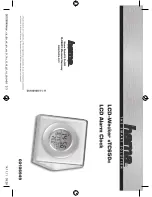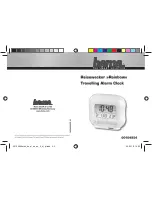
These installation instructions provide essential information for installing VESDA-E VEU-UL Aspirating Smoke Detectors in accordance with the system design. Additional installation
and product documentation is listed below in the Reference Documents section.
VESDA-E VEU-UL Installation Instructions
System Components
The detector is shipped with the following components:
• 1 aspirating smoke detector
• 1 mounting bracket
• 1 mounting template for directly mounting the detector to the mounting surface
• 1 End of Line Resistor for the monitored GPI
• 1 installation instruction sheet
Prerequisites
• Completed system design.
• 24V DC Power Supply, compliant with local codes and standards.
• Screws and inserts that are appropriate for the mounting surface.
•
Type A to Type B USB Interface Lead for initial configuration of the detector.
•
Labels as specified in the system design, e.g. Sampling Point labels
• Cable glands that are compliant with the IP rating of the detector.
•
Conduit, as specified in the system design.
• 0.2 mm
2
to 2.5 mm
2
(24 - 14 AWG) wiring for relays.
•
A PC or laptop installed with Xtralis VSC for initial configuration.
• Standard connection instructions for where the detectors are to be added to a corporate
network.
Standards Compliance
UL
For Open Area installations, ASPIRE should be used to confirm the correct performance of the sampling
network; all sampling point sensitivities must be less than 5.0%/m (1.5%/ft). All pipework designs must be
modeled in ASPIRE to confirm that the rules for transport time and sensitivity are met for all sampling points
in the system.
Note that the maximum pipe length is dependent on pipe layouts and fittings used. Ensure that the
correct setting for UL7 mode in the Smoke Thresholds setting screen of Xtralis VSC is set correctly for the
application, special application modes permit higher sensitivities and must only be used where cooking will
not occur.
ULC
For open area, special applications, high velocity and DUCT protection the fire alarm threshold (setting) that
initiates an evacuation signal must be set such that the sensitivity of each sampling hole is more sensitive
than the values shown below as determined by the ASPIRE software.
Application
Hole Sensitivity (%/m)
Hole Sensitivity (%/ft)
Open Area/ Special
Applications
8.00
2.509
Open Area/ Special
Applications High Velocity
4.00
1.237
Duct
8.00
2.509
Specifications
% obs/m
%obs/ft
Min
Max
Min
Max
Measurement Range
0.000
32.0
0.0000
11.090
Sensitivity Range
0.001
20.0
0.0003
6.575
Threshold Setting Range
Alert
0.001
2.0
0.0003
0.614
Action
0.001
2.0
0.0003
0.614
Fire 1
0.001
2.0
0.0003
0.614
Fire 2
0.001
20.0
0.0003
6.575
Notes:
For open area, open area high velocity and duct protection the fire alarm threshold (setting)
that initiates an evacuation signal must be set such that the sensitivity of each sampling hole
is more sensitive than 10% obs/m (3.2 % obs/ft) as determined by Xtralis ASPIRE software.
For open area, the fire alarm threshold (setting) that initiates an evacuation signal must be
set such that the sensitivity of each sampling hole is less sensitive than 5.0% obs/m
(1.5% obs/ft) as determined by Xtralis ASPIRE software.
Power Consumption
Supply Voltage Range
18 – 30VDC (Nominal 24VDC)
Maximum Power
Consumption *
Quiescent
Alarm
VEU-A10-UL
0.84A
0.88A
VEU-A00-UL
Nominal Power
Consumption @ 24VDC
Quiescent
Alarm
Aspirator Setting
1
5
10
1
5
10
VEU-A10-UL
0.32A
0.41A
0.64A
0.35A
0.44A
0.67A
VEU-A00-UL
0.29A
0.38A
0.61A
0.32A
0.41A
0.64A
* Maximum current measured is from the supply voltage that generates the highest current.
Environmental Requirements
•
Temperature
•
Ambient:
32°F to 100°F (0°C to 38°C)
•
Sampled Air:
-4°F to 140°F (-20°C to 60°C)*
•
Humidity:
5% to 95% RH, non-condensing
* The sampled air temperature shall be within the Ambient temperature specification at entry into the Detector.
Refer to Xtralis Design Guides and Application Notes for sampled air pre-conditioning.
Note:
Please consult your Xtralis representative for information on operation outside
these parameters or where sampled air is continually above 0.05% obs/m
(0.015% obs/ft) under normal operating conditions.
Reference Documents
Additional installation and product information is contained in the following documents,
which are available for download from Xtralis website (www.xtralis.com).
•
35712 - VESDA-E VEU-A00-UL Product Guide
•
35713 - VESDA-E VEU-A10-UL Product Guide
Installation Instructions
Notes
The VESDA-E detector can be mounted in an
upright or inverted position. Do not mount the
detector with a sideways orientation.
Ensure the mounting surface is flat as this allows an
airtight seal to be achieved between the sampling
pipe and the tapered air inlet pipes on the detector.
Refer to the detector Product Guide for information
on inverted mounting.
A
B
Ensure that there is sufficient clearance to mount
the detector, noting the location of air sampling
pipes and cable entry points. Due to the rigid nature
of the plastic pipe, installation must provide for
sufficient movement in all pipework (air inlet, air
exhaust and cable pipes) to allow pipe ends to be
easily fitted and removed.
•
A:
Minimum 50 mm (2 in.) below ceiling level.
•
B:
The detector can be mounted directly
against a wall or obstruction.
Attach the detector to the wall using the mounting bracket
Position the mounting bracket as specified by the system designer
E
F
B
D
A
C
D
G
G
G
G
G
• Position the mounting bracket (A) to allow sampling
pipes (B) and electrical conduit (C) to line up
horizontally with the alignment marks (D) and
vertically with the appropriate pipe depth line.
• 3/4 inch IPS (1.05 inch OD) sampling pipe should
vertically align with the top depth line (E).
• 25 mm OD sampling pipe should vertically
align with the bottom depth line (F).
• Hold the plate in position and mark positions
for 5 screw holes (G) on the mounting surface.
Remove the plate and drill holes. Insert plugs if
required.
Secure the mounting bracket to the mounting surface
B
B
D
D
A
D
C
C
• Align the mounting plate with the holes. Ensure
that the plate is level.
• Insert and tighten two screws (B) in the keyhole
slots (C) followed by three screws (D) in the
remaining slots.
• Use screws and inserts that are appropriate
for the mounting surface and the weight of the
detector.
Position the detector on the mounting bracket
A
A
A
B
C
• Align the mounting studs (A) on the rear of the
detector with the mounting stud slots on the
mounting bracket. Ensure that the center stud
(B) is in its slot.
• Slide the detector (C) down until the top of the
detector is flush with the top of the mounting
bracket.
Secure the detector to the mounting bracket
A
B
C
C
• Open the door on the front of the detector by
inserting a thin screwdriver (A) into the hole at
bottom left of the door (B) and firmly pushing
perpendicular to the door surface to release the
door latch.
• Remove the tape covering the partially inserted
locking screw (C).
• Tighten the locking screw.
Attach the detector directly to the mounting surface
Use the provided mounting template. Refer to the Product Guide for further information.
Note:
Do not remove the mounting studs from the rear of the detector as they are also
used to hold internal components in place.
Inverted Mounting
Some system designs require that the detector be inverted. Directions for correcting the
orientation of the fascia for an inverted detector are available in the Product Guide.




















